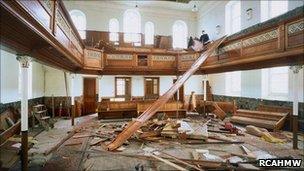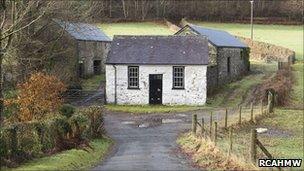Welsh chapels: race against time to record their fate
- Published

The Ebenezer chapel in Tumble is one of many that have been lost since the late 20th Century
Volunteers are being urged to help record the fate of chapels in Wales before any more are lost to demolition.
The Royal Commission on the Ancient and Historical Monuments of Wales (RCAHMW) has built a register of more than 6,600 19th and 20th Century chapels and now has data on just under half of them.
About 45% are still chapels, with 40% having other uses and 15% demolished.
Alternative uses include pubs, museums, theatres, workshops, homes and places of worship for other faiths.
The chapel is the key evidence of the nonconformist religious tradition which was at the centre of life in many Welsh communities during the 19th and early 20th Centuries.
Curators of an exhibition of chapel memorabilia at Ceredigion Museum in Aberystwyth have said that chapels are closing at the rate of one a week.
Architectural investigator Susan Fielding said the RCAHMW, based in Aberystwyth, had been documenting chapels for several years using census and other historical records, in association with the chapel heritage society Capel.
She said they were now keen to carry out a snapshot survey of the use of remaining chapels before any more disappear.
"Chapels are one of the classes of building most at threat of closure in Wales," she said.
"The wealth of variety that exists within chapel building, and precise principles of design that went into the architect-designed chapels, are now recognised as being on a par with other great public buildings of the late 19th Century.
"In a time when the official language of education and the workplace was English, it was the chapel that allowed much of the Welsh population to run part of their lives in Welsh and ensured the survival of the language in to the early 20th Century.

Peniel Independent Chapel at Glas Pwll near Machynlleth, built in 1822, is Grade II listed
"People often talk about one chapel a week closing but there is little statistical information currently available that can inform the scale of the issue."
Since summer 2010 the commission has been working with volunteers and nonconformist denominations to classify the use of chapel buildings.
Many people have used photo-sharing websites to contribute to the survey with the results appearing on the commission's Coflein website, external.
The findings of the Chapels Project will be published in a book about chapel architecture along with related web resources in 2012 and 2013.
The information will also be used by the commision and authorities like the heritage bod Cadw to identify historic chapel buildings at risk.
Anyone willing to help with the project can contact Susan Fielding at susan.fielding@rcahmw.gov.uk or 01970 621219.
- Published26 March 2011
- Published23 February 2011